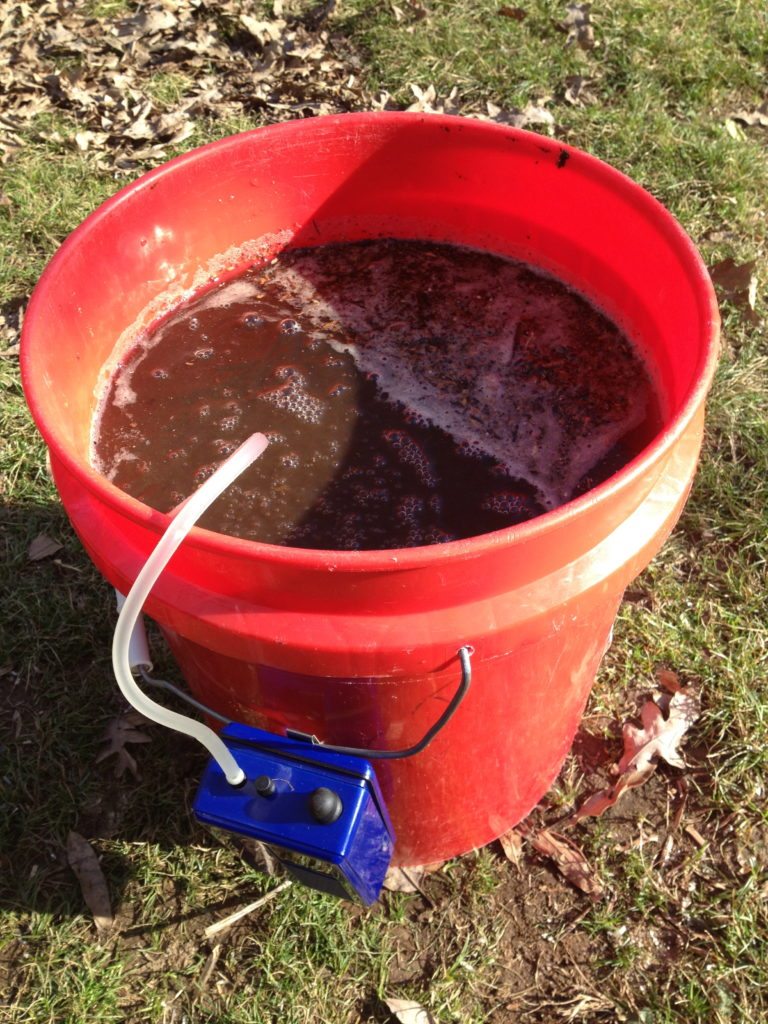Thursday, April 18, 2013
The Potatoes are growing!
The potato tower is finally starting to send out sprouts. I was beginning to think that part of our potato experiments wasn't going to be very successful. It certainly has taken a lot longer than the potato bag. Even the potatoes planted at the very top of the tower have only just come up. So far, I'd have to declare the potato bag as the winner for ease of use and amount of plant growth. Of course, the final winner won't be declared until we've seen the amount of potatoes actually produced.
Making Worm Tea!
| Tea Time, Garden Style |
This recipe gives you the option to use aquarium materials for ease and speed, or not. Based on experience, using the aquarium equipment will produce a higher yield or better quality tea, however, it can be done as long as you are diligent in your aerating efforts without the additional materials. Worm tea will not burn the plants in any way; however, you should avoid spraying in the heat of the day.
Ingredients:
5-gallon bucket
Tap water
Aquarium pump, air-line tubing, and air stone (optional equipment and runs about $20.00)
1 oz. of corn syrup or molasses (Make sure molasses does not contain sulfur)
2 1/2 - 3 cups worm castings
1 piece of fine mesh like pantyhose for filtering
 |
| Home Depot 5 Gallon Bucket With Aquarium Equipment Attached! |
Directions Non-Aquarium Equipment:
Fill the bucket with tap water 3/4 of the way full. See photo to the right. Let the water stand for 24 - 48 hours in order for the chlorine to evaporate out. This step is imperative, as chlorine will kill the beneficial micro-organisms rendering the tea useless. If you are using rainwater, eliminate the standing process.
Remove about one cup of the chlorine free water. Blend the corn syrup or the molasses into it. The micro-organisms utilize the corn syrup or molasses for food while your tea is brewing. Thinning it makes the food more readily available for them.
Add the corn syrup or molasses mixture back to the bucket. Stir until well blended. Dump in the 2 1/2 - 3 cups of worm castings. It does not have to be exact. Mix well, but gently. You don't want to harm all those cute little microbes in there.
Some people will put the castings in pantyhose or a fine mesh teabag like material. In trying different methods over the years, I have found this does not allow the microbes to move freely in the water and slows their growth tremendously. This method is only wise if you are using an air stone or bubbler.
Let the worm tea stand for 3 days stirring occasionally to aerate. Before utilizing aquarium equipment, I would stir four to six times per day. Once again, do so gently.
Presto, you have just made your first batch of worm tea! If you are using a watering can for soil application, there is no need to filter your finished product. However, if you will be applying with a sprayer for foliage feeding, you must strain to remove the particles that will clog the nozzle. Pantyhose or anything with a 400 micron filtration work exceptionally well for this step.
Use finished tea within 36 - 48 hours while the microbes are the most biologically active. If any unpleasant odors develop after the initial brewing, do not use the tea, as this signals the death of the beneficial microbes and the mixture should be dumped. It can go into the compost pile, just don't use it on your vegetation.
Caution: This tea is not for human consumption. Just thought I would throw that out there since most gardeners will try anything once!
Additional Directions for an Air Stone or Bubbler System:
 |
| Got Tea? |
After filling the bucket 3/4 of the way full, assemble the aquarium equipment. Place the air stone in the bottom of the bucket and aerate the water using your pump for 3 to 4 hours to remove all chlorine.
Blend the corn syrup or molasses with two cups of chlorine free water to avoid clogging the air-stone. Trust me on this one!
Add the corn syrup or molasses mixture back to the bucket. Dump in the castings and let your pump do the rest. Aerate for 24 hours, filter the finished product and your tea is ready to go.
The thing I like the best about using the aquarium equipment is the speed at which a higher quality tea can be made. Spraying on a routine basis adds the beneficial microbes and nutrients to the soil and the plants, thus, providing the proper balance they need to help repel insects and fight off disease. In addition, if you notice your plants are not taking off or they seem to be a little sluggish, this is a wonderful recipe to perk them right up. Many references on the topic also state that the use of worm or compost tea not only provides the beneficial microbes and nutrients, but also increases the overall fruit and flowering production of the plant. For those making compost, you can also brew compost tea in much the same fashion. This is a wonderful link for additional compost tea recipes.
http://www.compostjunkie.com/compost-tea-recipe.html
Happy Brewing!
Denise, Beds 25 & 29
Subscribe to:
Comments (Atom)


